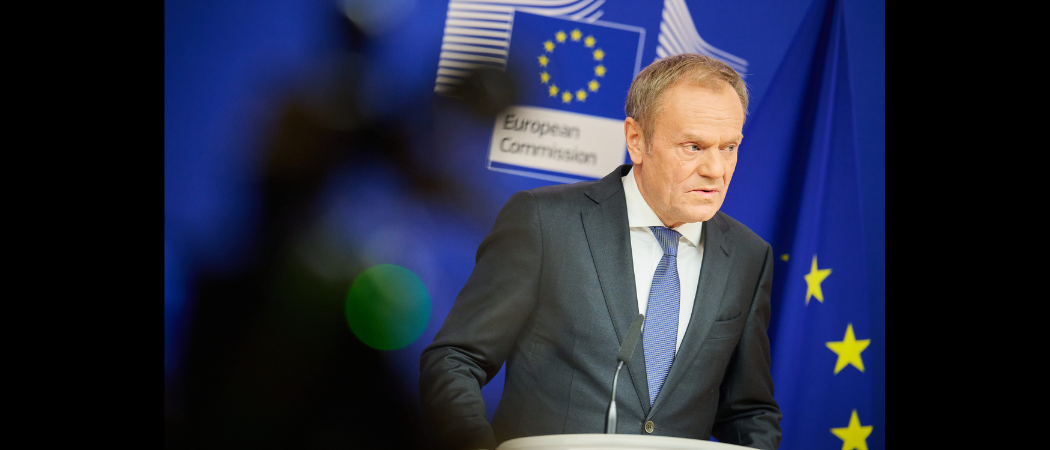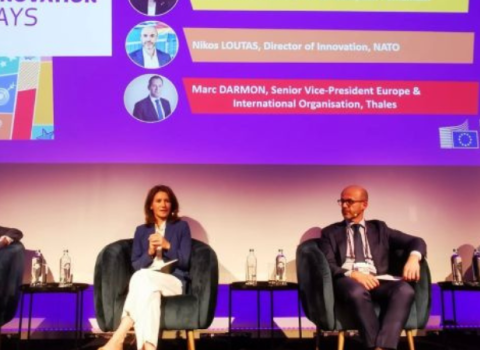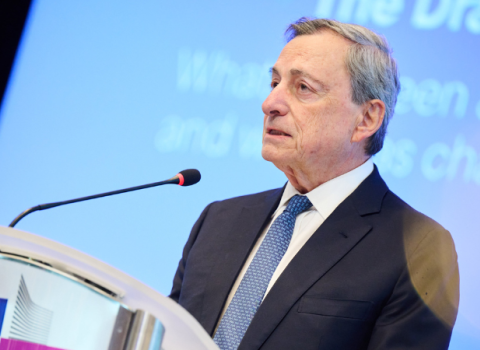Science|Business sits down with two ministers from Poland’s Ministry of Science and Higher Education to discuss the future of European research and the necessity of dual-use technologies

Polish Prime Minister Donald Tusk. Photo credits: Dati Bendo / European Union
The Polish government is backing the inclusion of dual-use technologies in the EU’s next seven-year research and innovation funding programme, due to start in 2028, saying the tense geopolitical situation makes it vital.
“This matter is extremely important to us,” said Maria Mrówczyńska, undersecretary of state at the Ministry of Science and Higher Education. “Especially in the current geopolitical standing, it seems necessary to us to further develop technologies that could be used for defence purposes as well as civil,” she said.
To date, the EU’s research framework programmes have been for civilian technologies only. In January this year, the European Commission put out a white paper to collect opinions on whether or not the next programme, FP10, should also be used to fund research that has the potential to be used for military purposes, as well as civilian. The consultation period is open until the end of this month.
Opening up the EU’s research programme to dual-use technologies is controversial. Margareth Hagen, rector of the University of Bergen in Norway, outlined in an opinion piece for Science|Business her arguments against it. One worry, “is whether opening FP10, even just parts of it, for defence-related research will result in a shift of focus, so that research and innovation for other purposes, and especially basic research, will lose out in budget discussions.”
But in Poland, discussions are moving ahead on what opportunities there are to better fund dual-use technologies. Mrówczyńska highlighted areas such as 3D printing and data transfer and storage as ones that could benefit from funding dual-use research.
Beyond dual-use, Poland is in the process of discussing its broader position on FP10. The government expects to publish an opinion on this in September. One area the government is keen to see continued is the Widening programme, designed to help close the research and innovation gap between Europe’s best and lowest performing countries.
The Danish government set out its position on FP10 earlier this year, calling for the Widening measures to be financed outside the next framework programme, for example through EU regional funds.
Andrzej Szeptycki, vice minister of research and higher education, sitting alongside Mrówczyńska, said he is against this. “We are attached to the idea of Widening because we believe this is an important instrument in helping the science community here in the [EU’s] newer member states,” he said.
Elsewhere, he wants FP10 to be more flexible and better able to respond to shifting global crises. “What we've seen during the last 10 to 15 years is that every two years a new crisis that almost nobody predicted comes along. Probably, that's not the end and we would need an instrument that can quickly respond, like in the case of COVID-19, to new unexpected challenges,” he said. “That's what we need science for.”
On Poland’s performance in the current framework programme, Horizon Europe, Mrówczyńska is aware of the need to do better. The country is 16th on the list in terms of money won from the programme, and is the third best-performing of the 15 Widening countries, behind Greece and Portugal. This is promising, but given Poland’s size and population it could be better. “We know what our weaknesses are,” Mrówczyńska. “We would like very much to overcome these in order for us to get more funds from the Horizon Europe programme.”
She said the government is aiming to provide universities and research institutes with better support for their applications to European projects, and is also looking into a scheme to incentivise participation in EU projects through a rewards system.
Support for Ukraine
One reason for Poland’s support for dual-use technologies could be its proximity to Ukraine, where Russia has been waging a full-scale invasion since February 2022. Poland is now the NATO member that spends the highest proportion of its GDP on defence, projected to be over 4% this year. Other near neighbours of Russia or Ukraine, such as Estonia, Lithuania, Finland, Romania, Hungary and Latvia are also in the top 10 highest spenders as a percentage of GDP.
Poland has been a destination for many Ukrainian scholars fleeing the war. Before Russia’s invasion, there were around 500 Ukrainian academics working in Poland; in the last two years another 500 - 600 more have joined them.
Szeptycki said that while at first the priority was providing Ukrainian academics with opportunities to come to Poland, the emphasis has now shifted to helping them continue their work at Ukrainian universities or institutions, whether remotely or on the ground.
“Ukraine now faces a demographic crisis of an unexpected scale,” Szeptycki said. The country’s population was over 50 million in the early 1990s but has now fallen to under 40 million. The Ukrainian government has said that it could fall by another 10 million in the next three decades. While Russia’s invasion has accelerated this trend, it is not the only cause, with high mortality rates among the male population due to lifestyles, and young and talented people moving abroad for economic reasons, contributing to the decline.
Szeptycki said is important not to contribute any more to the brain drain from Ukraine. “What we want is for Ukrainian academics to be able to maintain their positions at universities or research institutions in Ukraine and work there either in an online capacity from Poland or to work there in person but to have links with Poland,” Szeptycki said.
Poland is also involved in numerous support schemes to help Ukrainian scholars, including through a scheme with the US and the Baltic states called the International Multilateral Partnerships for Resilient Education and Science System in Ukraine.
Weimar Triangle
In January this year Szeptycki travelled to Brussels to meet counterparts from Germany and France to discuss closer collaboration on artificial intelligence and a renewal of the Weimar Triangle format.
The Weimar Triangle was launched in 1991 when the three countries agreed to work together on European issues, with France and Germany helping Poland transition from the communist regime that had just collapsed. The model could be used again, but this time with Poland also a leader, being the richest of the EU member states that joined the bloc after 2004.
Details are still scarce on how exactly the three countries plan to work together on AI, but Szeptycki said there are some “interesting ideas” being discussed. For example, Germany and France are talking about creating a European AI centre that Poland could later get involved with. There has also been a suggestion to make the European University Viadrina, based in Frankfurt, a “Weimar” university.
Poland is also planning a new interstate treaty with France that would include a science and education component.
In terms of Polish alignment with France and Germany on broader science policy issues, such as the nature of FP10, Szeptycki spoke of maintaining an open dialogue. There are some differences, especially on the Widening programme, but Szeptycki says it’s not something that cannot be overcome. “That’s why we are talking about it,” he said.
This is a different approach from Poland’s previous government, headed up by Jarosław Kaczynski of the Law and Justice Party (PiS). Kaczynski lost out in elections last year, with pro-European Donald Tusk and his Civic Platform party forming a new government in December.
Szeptycki said that the new government is focused on building relations with its European neighbours, rather than getting caught up in the differences.
“The relations were difficult under our predecessors. They relied very much on anti-German and anti-European rhetoric and this had an impact on academic cooperation,” he said.
“So, even now if there are some differences, it makes them less important because we have this common will with Berlin and Paris to get out of the situation that was made by the previous [government].”
Editor’s note: This article is the first in a two-part series looking at Poland’s R&I landscape following last year’s general election and the re-establishment of a separate ministry for science and higher education. Read part two on Poland's efforts to boost R&I domestically here.





 A unique international forum for public research organisations and companies to connect their external engagement with strategic interests around their R&D system.
A unique international forum for public research organisations and companies to connect their external engagement with strategic interests around their R&D system.